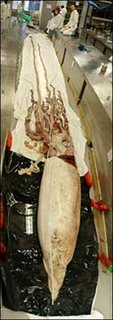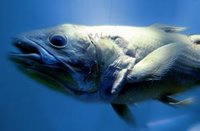 Reception staff at the Natural History Museum in London were in no doubt about the message they wanted to be passed to future visitors. 'Please, please tell your readers they cannot come to see the squid unless they book,' pleaded one.
Reception staff at the Natural History Museum in London were in no doubt about the message they wanted to be passed to future visitors. 'Please, please tell your readers they cannot come to see the squid unless they book,' pleaded one.Over the past four days thousands have arrived to see Archie, the giant squid, after news of his unveiling - in a tank of pickling fluid in the basement of the museum's Darwin Centre - had been revealed in newspapers and on television.
Only a few who had booked to go on the small guided tours of the Darwin Centre, the museum's research annexe, got to see the 30ft behemoth in his new home. The rest had to do without - and judging from the looks of museum staff, this news often went down badly.
The intensity of the public's response to Archie's arrival has been extraordinary, and reveals how deeply ingrained is our sense of wonder at the natural world, and the reverence we feel for our fellow creatures. It might be expected - given the plethora of natural history programmes on Discovery and National Geographic channels - that people would be bored by news of yet another zoological discovery.
But that is certainly not the case, judging by the response to the news that the most complete giant squid ever found (off the Falkland Islands) had been put on display at the Natural History Museum, and the public's recent reaction to a host of other zoological events. Examples range from the plight of the whale trapped in the Thames in January, to the millions that will be tuning in to BBC1's latest David Attenborough extravaganza, Planet Earth. We are becoming ever more besotted with animals, it appears.
And it is not simply a matter of aesthetics. Some animals are cute, but Archie - named after his formal label Architeuthis dux - is decidedly ugly, a very long, thin, pinkish creature with collapsed eye sockets the size of dinner plates. Only a restaurateur could love Archie, you would have thought - 'You could get about 600 portions of calamari out of him,' admitted one particularly pragmatic member of museum staff. Nevertheless, he is gazed upon in silent awe by visitors.
'We have always been intrigued with wildlife, of course, but it is true that the public's appetite only seems to be growing,' said Richard Lane, the museum's director of science. 'The real irony is that, just as we are discovering more and more new species, about 15,000 a year, we are killing off other species at an equivalent rate because of habitat destruction and climate change.'
There are 1.7 million species so far discovered by scientists, most of whom believe there could be up to 10 million in total on Earth.
 Among discoveries made in the last few weeks are a new species of rodent called Kha-Nyou (the name given to it by local people in central Laos); a marine worm called Osedax mucofloris which translates, rather beautifully, as the 'bone-eating snot-flower'; a golden-mantled tree kangaroo, found in Indonesia's Papua province; Berlepsch's six-wired bird of paradise, known to the Victorians but a mystery to modern ornithologists; and the world's smallest vertebrate, a species of fish called Paedocypris progenetica. This last wonder, a mere 8mm long, is smaller than a fly and was discovered on Sumatra by an international team that included museum researcher Ralf Britz.
Among discoveries made in the last few weeks are a new species of rodent called Kha-Nyou (the name given to it by local people in central Laos); a marine worm called Osedax mucofloris which translates, rather beautifully, as the 'bone-eating snot-flower'; a golden-mantled tree kangaroo, found in Indonesia's Papua province; Berlepsch's six-wired bird of paradise, known to the Victorians but a mystery to modern ornithologists; and the world's smallest vertebrate, a species of fish called Paedocypris progenetica. This last wonder, a mere 8mm long, is smaller than a fly and was discovered on Sumatra by an international team that included museum researcher Ralf Britz.'It's great when you discover something,' he said. 'Especially when it is a creature as tiny and bizarre as this one. But for every day you spend in the field looking for new animals, you have to spend 20 studying what you bring back and work out its relationships with other creatures.'
The Natural History Museum provides a home to 70 million different specimens. In terms of biodiversity, there is nothing else like it. In the Darwin Centre, and in the museum's vaults, millions of insects lie pinned to pieces of cardboard, while there is rack after rack of bottles of formaldehyde filled with snakes, dolphins, frogs, dogs, cats, apes and countless other creatures. These specimens are the gold standards of the animal world and provide the basic data that have allowed scientists to unravel the history of natural selection on Earth.
At present, however, Archie is the star of the show. There in a long, thin, perspex tank lies the animal known in legend as the 'kraken', which has featured in a host of adventure stories including 20,000 Leagues Under the Sea and Doctor No. But how long he will retain his number one billing, it is hard to say.
 Just to one side of his tank, a cylinder contains a 4ft fish: a coelacanth, once thought to have become extinct millions of years ago but discovered - to great media attention - in the Indian Ocean in 1938. Today it gathers dust, while Architeuthis dux hogs the limelight...
Just to one side of his tank, a cylinder contains a 4ft fish: a coelacanth, once thought to have become extinct millions of years ago but discovered - to great media attention - in the Indian Ocean in 1938. Today it gathers dust, while Architeuthis dux hogs the limelight...
No comments:
Post a Comment